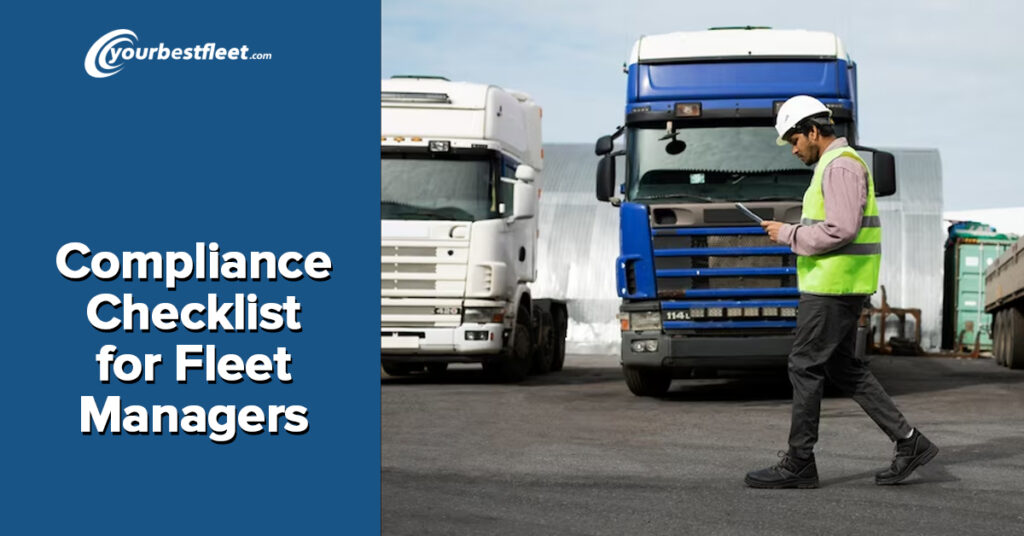As a fleet manager in 2025, you’re witnessing the change in the logistics industry brought by technological advancements and the eagerness of authorities to adopt new tech to make this industry safer for all. It is a crucial part that you play a big picture to ensure that fleet activities are safe, trustworthy, and legal. In this competitive field, following the rules set by regulators is not only necessary, it’s also a surefire way to succeed.
According to a 2022 fleet safety report, there’s an average of 4.5 accidents per driver annually. This guide navigates the essential elements of fleet management compliance, aiming to elevate your operations beyond merely meeting industry standards to enhancing safety and efficiency.
Compliance Essentials for Fleet Managers
Adhering to compliance protocols is vital for accuracy, safety, and optimal resource utilization. It allows fleet managers to focus on optimizing operations and boosting fleet efficiency. This comprehensive checklist guides you from understanding the significance of hours of service rules to systematically managing inspection reports and turning regulatory requirements into opportunities for excellence.
Understanding Hours of Service (HOS) Regulations
In fleet management, adhering to Hours of Service (HOS) regulations is crucial for driver safety and operational efficiency. These regulations, designed to prevent driver fatigue, include:
- 11-Hour Rule: Drivers can drive for a maximum of 11 hours within a 14-hour window, following ten consecutive hours off duty.
- 14-Hour Window: This rule requires drivers to complete their driving within 14 hours.
- 30-Minute Break: Drivers must take a 30-minute rest after eight hours of duty.
- 60/70 Hour Limit: Limits driving to 60 hours in 7 days or 70 hours in 8 days.
- 34-Hour Restart: Allows drivers to reset their 60 or 70-hour limits after 34 consecutive hours off duty.
Ensuring Safety Compliance
Commercial vehicle accidents are often linked to driver fatigue. The compliance audit focuses on limiting service hours to prevent accidents due to overwork or fatigue.
Documenting HOS is essential in audits, requiring detailed logging of driving, breaks, and rest periods. Records of Duty (RODS) must include the date, total distance, vehicle number, carrier’s name, office location, driver’s details, time zone, hours classified (driving, sleeping, on/off duty), shipping details, and additional information like duty status changes.
Implementing Electronic Logging Devices (ELDs)
The Federal Motor Carrier Safety Administration (FMCSA) mandates commercial vehicles to use ELDs for safe practices and accurate recordkeeping. Benefits include:
| Feature | Benefit |
|---|---|
| Automated Driving Time Recording | Reduces human error |
| RealTime Data Access | Facilitates proactive HOS compliance management |
| Alerts for Potential HOS Violations | Enables timely corrective actions |
| Efficient RecordKeeping | Simplifies documentation processes |
| Data Analysis for Planning | Improves schedules and routes |
| Enhanced Driver Control and Accountability | Promotes a safer work environment |
| Reduced Administrative Tasks | Allows more driving time |
Adhering to IFTA Regulations
Compliance with the International Fuel Tax Agreement (IFTA) is a complex but essential part of fleet management, focusing on detailed reporting and recordkeeping. Key aspects include:
- IFTA Requirements: Reporting fuel usage, mileage, and efficiency for equitable fuel tax distribution.
- Automated Data Logging: Efficient data collection for accurate IFTA reporting.
- Effective Reporting Solutions: Software-generated reports streamline the submission process.
- Real-Time Tracking: Advanced systems provide immediate data on fuel usage and travel records, aiding compliance.
Driver Vehicle Inspection Reports (DVIR)
Daily driver vehicle inspection reports are vital to ensure the fleet vehicles’ safety and keep them in the best working condition. Here’s an overview of their significance and the involved procedures:
Pre-Trip Inspection
One of the most critical steps in compliance and safety is checking the vehicle before taking it out on the road, also known as the pre-trip inspection. It helps in identifying and addressing potential safety hazards before the journey. This inspection covers critical vehicle components like tires, brakes, lights, and mirrors, checking for wear, damage, or malfunction.
Post-Trip Inspection
Post-trip inspections are crucial for detecting any issues that may have arisen during the journey. Addressing these issues promptly can prevent major faults and delays, enhancing overall fleet efficiency.
Maintaining Records
After completing the vehicle inspection, drivers must document any deficiencies in the Driver Vehicle Inspection Report (DVIR). This documentation is crucial for quick repair actions, preventing future breakdowns, and ensuring vehicle safety.
Accessibility of Reports
The DVIR should be readily available to authorities responsible for addressing the noted issues through necessary repairs and maintenance. Early detection through DVIRs enables prompt and effective vehicle maintenance.
Accountability
Drivers are vital in maintaining vehicle safety by conducting these inspections and reporting issues. The motor carrier must ensure that all necessary corrective actions have been taken and that the vehicle is safe for operation.
Drug and Alcohol Testing
Adhering to regulations for drug and alcohol testing in the fleet industry is crucial for legal compliance and road safety. The essential elements of an effective testing program include:
- Testing Requirements: FMCSA and DOT require testing to mitigate risks to individual and public safety.
- Conditions for Testing: Mandatory testing situations include pre-employment, post-accident, random, return to duty, reasonable suspicion, and follow-up.
- Registration: Fleets managing testing programs must register with a DOT-approved consortium.
- Compliance Criteria: Testing methods must adhere to DOT standards for validity and reliability.
- Substances Tested: Prohibited substances include PCP, cocaine, opiates, amphetamines, and marijuana.
- Alcohol Limits: The FMCSA sets a blood alcohol content limit of 0.04% for commercial drivers.
- Testing Methodologies: Strict protocols and certified labs are necessary for testing.
- Medical Review Officer Involvement: An MRO verifies the accuracy of test results.
- Recordkeeping: Employers must meticulously document all testing activities.
- Confidentiality: Test results are private and must be handled discretely.
Driver Qualification (DQ) Files
- Maintaining driver qualification (DQ) files is essential in fleet management to ensure compliance with regulations. Critical components of these files include:
- Annual Review: Regular examination of each driver’s violation record and updates to the DQ file for any changes or violations.
- Road Test Evaluation Report: A detailed assessment of the driver’s road test to verify their capability for safe driving.
- Training Records: Documentation of safety training received by drivers, including signatures confirming participation and understanding.
- ELD Compliance Guidelines: Clear instructions for drivers on Electronic Logging Devices (ELD) compliance and implications of non-compliance.
Mandatory FMCSA Compliance Audits
FMCSA conducts compliance audits to confirm motor carrier records in various safety-related areas. Though the nature of the audits may vary, the general methodology and goal will always be the same. The various audit types are listed below.
New Entrant Safety Audit (NESA)
Typically, this audit takes place during the first six months of fleet operations. For the new entrant, this safety audit will keep an eye on how well your fleet manager complies with safety requirements.
Onsite Audit
This onsite audit will examine every aspect of your business operations to make sure fleet businesses are following all necessary safety procedures as per law.
Audit of Hazardous Materials
This particular audit is carried out to evaluate the transporter’s responsibility and competence in handling hazardous commodities, such as highly reactive materials, hazardous waste, and marine pollutants.
Conclusion
For fleet managers attempting to deal with the array of fleet management laws, a detailed compliance checklist is essential. This article highlights the importance of maintaining accurate hours of service records and adhering to the International Fuel Tax Agreement, as well as conducting regular drug and alcohol testing and preserving complete driver qualification files, all of which play an essential part in ensuring safety standards and legal compliance.
By strictly adhering to these principles, fleet managers not only protect their operations from legal obligations but also significantly contribute to road safety, ultimately building a culture of responsibility and efficiency within their fleet operations.
James Johnson is a former truck driver who now works as a writer, specializing in the trucking industry. With over 15 years of experience on the road, James has a unique perspective on the challenges and opportunities faced by truck drivers and the trucking industry as a whole. His writing focuses on issues such as safety, regulation, and the latest industry trends. His work has been featured in several trucking publications and he has received recognition for his contributions to the industry. In his free time, James still enjoys being around trucks and often attends truck shows and other industry events.


